
Salmon can be prepared in many forms, from sandwiches to casseroles, on salads or as the main protein in fillet or steak form. Sometimes, a recipe calls for the salmon to be "flaked" before it is served. Flaking salmon isn't a difficult task, and occurs after the fish has gone through the cooking process. You can prepare a salmon for flaking using most common cooking methods, like grilling, poaching, roasting or steaming. Once the fish is done, you should be able to flake it easily using either a fork or your hands.
Step 1
Cook your salmon according to the recipe you are using. The flesh of properly cooked salmon will look opaque. The foodsafety.gov website recommends cooking fin fish like salmon to 145 degrees Fahrenheit. Once it's hit that temperature, the flesh should flake naturally and without any resistance.
Step 2
Place the piece of salmon in a mixing bowl, on a plate or on a clean cutting board. Remove small bones in a salmon steak or fillet with tweezers prior to flaking.
Step 3
Grip a standard dinner fork in each hand. Hold the salmon down on the plate or in a mixing bowl with one fork and pull the other fork against the flesh to remove small pieces or flakes.
Step 4
Continue to pull small flakes off the salmon with the fork until the entire piece of salmon is flaked. Discard the skin if it was still on the fillet or salmon steak as part of the recipe.
Step 5
Wear clean rubber kitchen gloves and pull the salmon into small flakes by hand if you don't want to use the fork method.
Step 6
Serve your flaked salmon as part of salmon cakes, salmon burger patties, salmon croquettes, with pasta or in a salmon salad. Flaked salmon can work with virtually any theme you want to use for your dish, and once it's in pieces can be easily folded into one-pot dishes like casseroles and stir-fries.
Related Articles
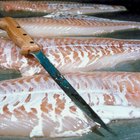
How to Grill a Cod Fish

How to Grill Stuffed Salmon

How to Cook Salmon on a Griddle
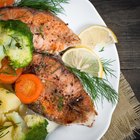
How to Cook a Salmon Steak in the Oven
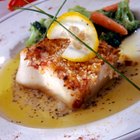
How to Pan Sear Sea Bass
How to Cook Atlantic Cod Fillets
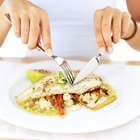
How to Cook Grunt Fish

How to Cook Whole Butterfish

How to Cook Mackerel in an Oven

How to Prepare Rattlesnake for Cooking
How to Bake Salmon So It's Tender
How to Cook Salmon to Moist & Tender ...

How to Cook Pickerel in the Oven

How to Cook Frozen, Boneless & Skinless ...

How to Cook Jamaican Jerk Salmon
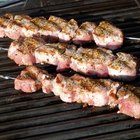
How to Cook Pork Loin

How to Cook Rockfish in the Oven

How to Cook Salmon in a Steam Bag

How to Flake Canned Salmon
How to Cook Ladyfish
References
Tips
- Store fresh salmon for up to two days in your refrigerator before cooking it.
- The fat content of salmon may cause flare-ups when cooking it on the barbecue, so roasting or steaming the fish might be preferred methods for new cooks.
Warnings
- Never purchase a fresh salmon that has a "fishy" odor.
Writer Bio
Joshua McCarron has been writing both online and offline since 1995. He has been employed as a copywriter since 2005 and in that position has written numerous blogs, online articles, websites, sales letters and news releases. McCarron graduated from York University in Toronto with a bachelor's degree in English.
Photo Credits
Jupiterimages/Comstock/Getty Images